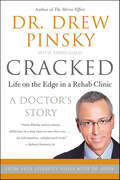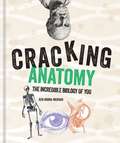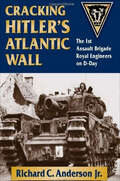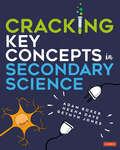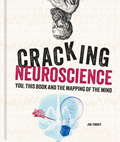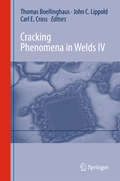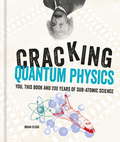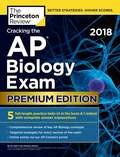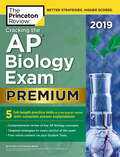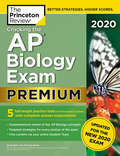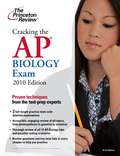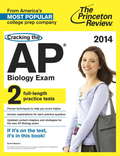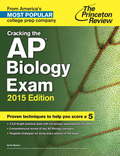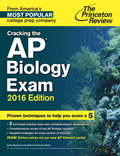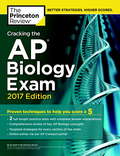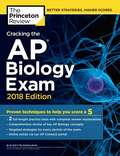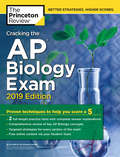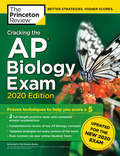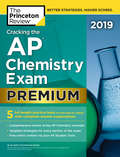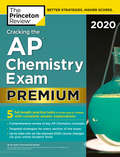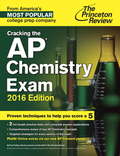- Table View
- List View
Cracked: Life on the Edge in a Rehab Clinic, A Doctor's Story
by Drew Pinsky Todd GoldDr. Drew Pinsky is best known as the cohost of the long-running radio advice program Loveline. But his workday is spent at a major Southern California clinic, treating the severest cases of drug dependency and psychiatric breakdown. In this riveting book, Pinsky reveals the intimate and often shocking stories of his patients as they struggle with emotional trauma, sexual abuse, and a host of chemical nemeses: alcohol, marijuana, Ecstasy, heroin, speed, cocaine, and prescription drugs. At the center of these stories is Pinsky himself, who immerses himself passionately, almost obsessively, in his work. From the sexually compulsive model to the BMW-driving soccer mom, Cracked exposes, in fast-moving, powerful vignettes, the true scope and severity of addiction, a nationwide epidemic.
Cracking Anatomy
by Ken Okona-MensahFrom your dividing cells to your beating heart, this book takes a comprehensive look at the human body and reveals the extraordinary way your anatomy and physiology intertwine.In 13 illustrated chapters, Cracking Anatomy makes sense of all the body's systems, explains medical terminology and explores questions including:· How does your brain really see you?· How does age affect your muscles and bones? · How and why cells die?· Why the shape of a criminal's hands could be used to help identify them?· Can you exercise too much? · Which of the five senses is most important?· What triggers puberty?· Why your immune system has more than one line of defence?· Why anatomical quirks are more important than you think?· How long does it take for your body to digest food? · How many times does your heart beat in a day?· Why do we sleep?An accessible, comprehensive and fully illustrated guide to this absorbing area, Cracking Anatomy will both educate and excite all readers.
Cracking Anatomy (Cracking Series)
by Ken Okona-MensahFrom your dividing cells to your beating heart, this book takes a comprehensive look at the human body and reveals the extraordinary way your anatomy and physiology intertwine.In 13 illustrated chapters, Cracking Anatomy makes sense of all the body's systems, explains medical terminology and explores questions including:· How does your brain really see you?· How does age affect your muscles and bones? · How and why cells die?· Why the shape of a criminal's hands could be used to help identify them?· Can you exercise too much? · Which of the five senses is most important?· What triggers puberty?· Why your immune system has more than one line of defence?· Why anatomical quirks are more important than you think?· How long does it take for your body to digest food? · How many times does your heart beat in a day?· Why do we sleep?An accessible, comprehensive and fully illustrated guide to this absorbing area, Cracking Anatomy will both educate and excite all readers.
Cracking Hitler's Atlantic Wall: The 1st Assault Brigade Royal Engineers on D-Day
by Richard C AndersonA military historian analyzes the ingenious WWII tanks known as Hobart&’s Funnies, detailing their development and their role in the D-Day campaign. When the British and Canadians landed in Normandy on June 6, 1944, they were accompanied by specialized armored vehicles designed to remove German obstacles and mines. Developed by the Royal Engineers, these tanks known as Hobart's Funnies featured a range of ingenious innovations, from carpet-laying and bridge-laying devices to a giant 290-millimeter mortar. Examining these vehicles from technical development to combat deployment, military historian Richard C. Anderson Jr. gives a minute-by-minute account of D-Day's early hours on Sword, Juno, and Gold Beaches—the critical moments when success hinged on the assault engineers&’ ability to clear a path or breach the seawall. Anderson also describes the events on Omaha and Utah Beaches, where U.S. troops, despite being offered these vehicles, stormed ashore without them. Through careful comparison of conditions and outcomes, Anderson assesses the vehicles&’ performance and impact on D-Day's successes and failures.
Cracking Key Concepts in Secondary Science (Corwin Ltd)
by Adam Boxer Heena Dave Gethyn JonesThe perfect companion to help you crack some of secondary science’s most challenging concepts in your teaching. Secondary science teaching is a heroic task, taking some of humanity’s greatest discoveries and explaining them to the next generation of students. Cracking some of the trickiest concepts in biology, chemistry and physics, with walkthrough explanations and examples inspired by direct instruction, this book will bring a fresh perspective to your teaching. · 30 key concepts explored in depth · Understand what students should know before and after the lesson · Tips and tricks offer detailed advice on each topic · Checks for understanding so you can test your students’ knowledge Adam Boxer is Head of Science at The Totteridge Academy in North London. Heena Dave was Head of Science at Bedford Free School. Gethyn Jones is a teacher of physics at an independent school in London
Cracking Key Concepts in Secondary Science (Corwin Ltd)
by Adam Boxer Heena Dave Gethyn JonesThe perfect companion to help you crack some of secondary science’s most challenging concepts in your teaching. Secondary science teaching is a heroic task, taking some of humanity’s greatest discoveries and explaining them to the next generation of students. Cracking some of the trickiest concepts in biology, chemistry and physics, with walkthrough explanations and examples inspired by direct instruction, this book will bring a fresh perspective to your teaching. · 30 key concepts explored in depth · Understand what students should know before and after the lesson · Tips and tricks offer detailed advice on each topic · Checks for understanding so you can test your students’ knowledge Adam Boxer is Head of Science at The Totteridge Academy in North London. Heena Dave was Head of Science at Bedford Free School. Gethyn Jones is a teacher of physics at an independent school in London
Cracking Neuroscience (Cracking Ser.)
by Jon TurneyFor so long, the brain was the great unknown of human biology; an evolved complex of cells, chemicals and electricity, which eluded even the understanding of its own grey matter. Now, in this comprehensive guide, the most complicated concepts from across the field of neuroscience - such as memory, addiction and mind mapping - are broken down into easily understandable bite-sized pieces, to give everyone the chance to understand their own brain. Includes sections on:-The anatomy of the brain-Neurons, synapses and axons - the building blocks of the brain-Differences in male and female development-Modern treatment of mental illness-The effects on the brain of different food and stimulants-Memory, senses, cravings-Fight or flight-Perception and sensation-The future of neuroscience
Cracking Neuroscience (Cracking Series)
by Jon TurneyFor so long, the brain was the great unknown of human biology; an evolved complex of cells, chemicals and electricity, which eluded even the understanding of its own grey matter. Now, in this comprehensive guide, the most complicated concepts from across the field of neuroscience - such as memory, addiction and mind mapping - are broken down into easily understandable bite-sized pieces, to give everyone the chance to understand their own brain. Includes sections on:-The anatomy of the brain-Neurons, synapses and axons - the building blocks of the brain-Differences in male and female development-Modern treatment of mental illness-The effects on the brain of different food and stimulants-Memory, senses, cravings-Fight or flight-Perception and sensation-The future of neuroscience
Cracking Phenomena in Welds IV
by John C. Lippold Thomas Boellinghaus Carl Edward CrossThis is the fourth volume inthe well-established series of compendiums devoted to the subject of weld hotcracking. It contains the papers presented at the 4th InternationalCracking Workshop held in Berlin in April 2014. In the context of thisworkshop, the term "cracking" refers to hot cracking in the classical andprevious sense, but also to cold cracking, stress-corrosion cracking andelevated temp. solid-state cracking. A variety of different crackingsubjects are discussed, including test standards, crack prediction, weldabilitydetermination, crack mitigation, stress states, numerical modelling, andcracking mechanisms. Likewise, many different alloys were investigatedsuch as aluminum alloys, copper-aluminum dissimilar metal, austenitic stainlesssteel, nickel base alloys, duplex stainless steel, creep resistant steel, andhigh strength steel.
Cracking Quantum Physics
by Brian CleggEnter the invisible world of sub-atomic physics and discover the very core of existence. Cracking Quantum Physics takes you through every area of particle physics to clearly explain how our world was, and is, created, and breaks down the most complex theories into easily understandable elements. Subjects covered include:-Time travel-The Higgs field-Dark Matter-The anatomy of the elements-Enter the atom-Quantum reality-Quantum tunnelling-Electrodynamics-Accelerators and colliders-The Zeno effectAn easy-to-understand guide to some of the most complex and intriguing topics: Cracking Quantum Physics is a must-read for anyone who has ever wondered about the underlying forces and materials that make up the world as we know it.
Cracking Quantum Physics (Cracking Ser.)
by Brian CleggEnter the invisible world of sub-atomic physics and discover the very core of existence. Cracking Quantum Physics takes you through every area of particle physics to clearly explain how our world was, and is, created, and breaks down the most complex theories into easily understandable elements. Subjects covered include:-Time travel-The Higgs field-Dark Matter-The anatomy of the elements-Enter the atom-Quantum reality-Quantum tunnelling-Electrodynamics-Accelerators and colliders-The Zeno effectAn easy-to-understand guide to some of the most complex and intriguing topics: Cracking Quantum Physics is a must-read for anyone who has ever wondered about the underlying forces and materials that make up the world as we know it.
Cracking the AP Biology Exam 2018, Premium Edition
by Princeton ReviewPREMIUM PRACTICE FOR A PERFECT 5! Equip yourself to ace the AP Biology Exam with this Premium version of The Princeton Review's comprehensive study guide. In addition to all the great material in our classic Cracking the AP Biology Exam guide—thorough content reviews, targeted test strategies, and access to AP Connect extras via our online portal—this edition includes extra exams, for a total of 5 full-length practice tests with complete answer explanations! This eBook edition is optimized for on-screen learning with cross-linked questions, answers, and explanations.Everything You Need to Know to Help Achieve a High Score.• Comprehensive content review for all test topics• Up-to-date information on the 2018 AP Biology Exam• Engaging activities to help you critically assess your progress• Access to AP Connect, our online portal for helpful pre-college information and exam updatesPremium Practice to Help Achieve Excellence.• 4 full-length practice tests in the book with detailed answer explanations• 1 additional full-length practice test online (downloadable to replicate the AP paper-and-pencil testing experience)• Practice drills at the end of each content chapter• Lists of key terms in every content chapter to help focus your studyingTechniques That Actually Work.• Tried-and-true strategies to help you avoid traps and beat the test• Tips for pacing yourself and guessing logically• Essential tactics to help you work smarter, not harder
Cracking the AP Biology Exam 2019, Premium Edition: 5 Practice Tests + Complete Content Review (College Test Preparation)
by Princeton ReviewPREMIUM PRACTICE FOR A PERFECT 5! Ace the AP Biology Exam with this Premium version of The Princeton Review's comprehensive study guide. Includes 5 full-length practice exams, plus thorough content reviews, targeted test strategies, and access to online extras.Everything You Need to Know to Help Achieve a High Score.• Comprehensive content review for all test topics• Up-to-date information on the 2019 AP Biology Exam• Engaging activities to help you critically assess your progress• Access to online study plans, a handy list of key equations, helpful pre-college information, and morePremium Practice to Help Achieve Excellence.• 4 full-length practice tests in the book with detailed answer explanations• 1 additional full-length practice test online • Practice drills at the end of each content chapter• Lists of key terms in every content chapter to help focus your studyingTechniques That Actually Work.• Tried-and-true strategies to help you avoid traps and beat the test• Tips for pacing yourself and guessing logically• Essential tactics to help you work smarter, not harderWritten by Princeton Review experts who know their way around bio, Cracking the AP Biology Exam brings you premium practice for AP excellence.
Cracking the AP Biology Exam 2020, Premium Edition: 5 Practice Tests + Complete Content Review + Proven Prep for the NEW 2020 Exam (College Test Preparation)
by The Princeton ReviewPREMIUM PRACTICE FOR A PERFECT 5! Ace the 2020 AP Biology Exam with this Premium version of The Princeton Review's comprehensive study guide. Includes 5 full-length practice exams, plus thorough content reviews, targeted test strategies, and access to online extras.Techniques That Actually Work.• Tried-and-true strategies to help you avoid traps and beat the test• Tips for pacing yourself and guessing logically• Essential tactics to help you work smarter, not harderEverything You Need to Know to Help Achieve a High Score.• Comprehensive content review for all test topics• Up-to-date information on the 2020 AP® Biology Exam• Engaging activities to help you critically assess your progress• Access to study plans, a handy list of key terms and concepts, helpful pre-college information, and more via your online Student ToolsPremium Practice for AP Excellence.• 4 full-length practice tests in the book with detailed answer explanations• 1 full-length practice test online with detailed answer explanations• Practice drills at the end of each content review chapter• Lists of key terms in every content chapter to help focus your studyingWritten by Princeton Review experts who know their way around bio, Cracking the AP Biology Exam, Premium Edition brings you premium practice for AP excellence.
Cracking the AP Biology Exam, 2010 Edition
by Kim MagloireIn their Cracking the AP Exam guides, the Princeton Review team offers preparation strategies and test-taking techniques to raise scores, advice on how to focus only on the subject's topics that are likely to be covered on the test, and full-length practice tests--with explanations and answers for every question.
Cracking the AP Biology Exam, 2013 Edition (Revised)
by Princeton ReviewIf you need to know it, it's in this book! This eBook version of the revised 2013 edition of Cracking the AP Biology Exam has been optimized for on-screen viewing with cross-linked questions, answers, and explanations, and includes: * 2 full-length practice tests with detailed explanations * An overview of the subject matter changes made to the 2013 AP Biology Exam * A comprehensive biology test topic review, covering everything from photosynthesis to genetics to evolution * Strategies for the new grid-in and short free-response question types * Review questions and key term lists in every chapter to help you practice * Detailed guidance on how to write a topical, cohesive, point-winning essay
Cracking the AP Biology Exam, 2015 Edition
by Princeton ReviewEVERYTHING YOU NEED TO SCORE A PERFECT 5. Equip yourself to ace the AP Biology Exam with The Princeton Review's comprehensive study guide--including thorough content reviews, targeted strategies for every question type, and 2 full-length practice tests with complete answer explanations. This eBook edition has been specially formatted for on-screen viewing with cross-linked questions, answers, and explanations.We don't have to tell you how tough AP Biology is--or how important a stellar score on the AP exam can be to your chances of getting into a top college of your choice. Written by Princeton Review experts who know their way around Bio, Cracking the AP Biology Exam will give you:Techniques That Actually Work.* Tried-and-true strategies to avoid traps and beat the test* Tips for pacing yourself and guessing logically* Essential tactics to help you work smarter, not harderEverything You Need to Know for a High Score.* Comprehensive content review for all test topics* Up-to-date information on the 2015 AP Biology Exam* Engaging activities to help you critically assess your progressPractice Your Way to Perfection.* 2 full-length practice tests with detailed answer explanations* Practice drills at the end of each content review chapter* Lists of key terms at the end of each content review chapter
Cracking the AP Biology Exam, 2016 Edition
by Princeton ReviewEVERYTHING YOU NEED TO HELP SCORE A PERFECT 5. Equip yourself to ace the AP Biology Exam with The Princeton Review's comprehensive study guide--including 2 full-length practice tests, thorough content reviews, access to our AP Connect online portal, and targeted strategies for every section of the exam.This eBook edition has been specially formatted for on-screen viewing with cross-linked questions, answers, and explanations.We don't have to tell you how tough AP Biology is--or how important a stellar score on the AP Exam can be to your chances of getting into a top college of your choice. Written by Princeton Review experts who know their way around Bio, Cracking the AP Biology Exam will give you:Techniques That Actually Work.* Tried-and-true strategies to help you avoid traps and beat the test* Tips for pacing yourself and guessing logically* Essential tactics to help you work smarter, not harderEverything You Need to Know to Help Achieve a High Score.* Comprehensive content review for all test topics* Up-to-date information on the 2016 AP Biology Exam* Engaging activities to help you critically assess your progress* Access to AP Connect, our online portal for helpful pre-college information and exam updatesPractice Your Way to Excellence.* 2 full-length practice tests with detailed answer explanations* Practice drills at the end of each content chapter* Lists of key terms in every content chapter to help focus your studying
Cracking the AP Biology Exam, 2017 Edition
by Princeton ReviewEVERYTHING YOU NEED TO HELP SCORE A PERFECT 5. Equip yourself to ace the AP Biology Exam with The Princeton Review's comprehensive study guide--including 2 full-length practice tests, thorough content reviews, access to our AP Connect Online Portal, and targeted strategies for every section of the exam.This eBook edition is optimized for on-screen learning with cross-linked questions, answers, and explanations.We don't have to tell you how tough AP Biology is--or how important a stellar score on the AP Exam can be to your chances of getting into a top college of your choice. Written by Princeton Review experts who know their way around Bio, Cracking the AP Biology Exam will give you:Techniques That Actually Work.* Tried-and-true strategies to help you avoid traps and beat the test* Tips for pacing yourself and guessing logically* Essential tactics to help you work smarter, not harderEverything You Need to Know to Help Achieve a High Score.* Comprehensive content review for all test topics* Up-to-date information on the 2017 AP Biology Exam* Engaging activities to help you critically assess your progress* Access to AP Connect, our online portal for helpful pre-college information and exam updatesPractice Your Way to Excellence.* 2 full-length practice tests with detailed answer explanations* Practice drills at the end of each content chapter* Lists of key terms in every content chapter to help focus your studying
Cracking the AP Biology Exam, 2018 Edition: Proven Techniques to Help You Score a 5
by Princeton ReviewEVERYTHING YOU NEED TO HELP SCORE A PERFECT 5. Equip yourself to ace the AP Biology Exam with this comprehensive study guide—including 2 full-length practice tests, thorough content reviews, access to our AP Connect Online Portal, and targeted strategies for every section of the exam.This eBook edition has been optimized for on-screen learning with cross-linked questions, answers, and explanations. Written by Princeton Review experts who know their way around bio, Cracking the AP Biology Exam will give you:Techniques That Actually Work.• Tried-and-true strategies to help you avoid traps and beat the test• Tips for pacing yourself and guessing logically• Essential tactics to help you work smarter, not harderEverything You Need to Know to Help Achieve a High Score.• Comprehensive content review for all test topics• Up-to-date information on the 2018 AP Biology Exam• Engaging activities to help you critically assess your progress• Access to AP Connect, our online portal for helpful pre-college information and exam updatesPractice Your Way to Excellence.• 2 full-length practice tests with detailed answer explanations• Practice drills at the end of each content chapter• Lists of key terms in every content chapter to help focus your studying
Cracking the AP Biology Exam, 2019 Edition: Practice Tests + Proven Techniques to Help You Score a 5 (College Test Preparation)
by Princeton ReviewEVERYTHING YOU NEED TO HELP SCORE A PERFECT 5. Ace the AP Biology Exam with this comprehensive study guide—including 2 full-length practice tests, thorough content reviews, targeted strategies for every section, and access to online extras.Everything You Need to Know to Help Achieve a High Score.• Comprehensive content review for all test topics• Up-to-date information on the 2019 AP Biology Exam• Engaging activities to help you critically assess your progress• Access to online study plans, a handy list of key equations, helpful pre-college information, and morePractice Your Way to Excellence.• 2 full-length practice tests with detailed answer explanations• Practice drills at the end of each content chapter• Lists of key terms in every content chapter to help focus your studyingTechniques That Actually Work.• Tried-and-true strategies to help you avoid traps and beat the test• Tips for pacing yourself and guessing logically• Essential tactics to help you work smarter, not harderWritten by Princeton Review experts who know their way around bio, Cracking the AP Biology Exam gives you the tools you need for the score you want.
Cracking the AP Biology Exam, 2020 Edition: Practice Tests & Prep for the NEW 2020 Exam (College Test Preparation)
by The Princeton ReviewEVERYTHING YOU NEED TO HELP SCORE A PERFECT 5. Ace the 2020 AP Biology Exam with this comprehensive study guide—including 2 full-length practice tests, thorough content reviews, targeted strategies for every section, and access to online extras.Techniques That Actually Work.• Tried-and-true strategies to help you avoid traps and beat the test• Tips for pacing yourself and guessing logically• Essential tactics to help you work smarter, not harderEverything You Need to Know to Help Achieve a High Score.• Comprehensive content review for all test topics• Up-to-date information on the 2020 AP® Biology Exam• Engaging activities to help you critically assess your progress• Access to study plans, a handy list of key terms and concepts, helpful pre-college information, and more via your online Student ToolsPractice Your Way to Excellence.• 2 full-length practice tests with detailed answer explanations• Practice drills at the end of each content review chapter• Lists of key terms in every content chapter to help focus your studyingWritten by Princeton Review experts who know their way around bio, Cracking the AP Biology Exam gives you the tools you need for the score you want.
Cracking the AP Chemistry Exam 2019, Premium Edition: 5 Practice Tests + Complete Content Review (College Test Preparation)
by Princeton ReviewPREMIUM PRACTICE FOR A PERFECT 5! Ace the AP Chemistry Exam with this Premium version of The Princeton Review's comprehensive study guide. Includes 5 full-length practice exams, plus thorough content reviews, targeted test strategies, and access to online extras.Everything You Need to Know to Help Achieve a High Score. • Comprehensive content review for all test topics • Up-to-date information on the 2019 AP Chemistry Exam • Engaging activities to help you critically assess your progress • Access to online study plans, a handy list of key equations, helpful pre-college information, and morePremium Practice for AP Excellence. • 4 full-length practice tests in the book with detailed answer explanations • 1 additional full-length practice test online with detailed answer explanations • Practice drills at the end of each content chapter • Review of important laboratory procedures and equipmentTechniques That Actually Work. • Tried-and-true strategies to help you avoid traps and beat the test • Tips for pacing yourself and guessing logically • Essential tactics to help you work smarter, not harder Written by Princeton Review experts who know their way around chem, Cracking the AP Chemistry Exam will give you the help you need to get the score you want.
Cracking the AP Chemistry Exam 2020, Premium Edition: 5 Practice Tests + Complete Content Review (College Test Preparation)
by The Princeton ReviewEVERYTHING YOU NEED TO HELP SCORE A PERFECT 5. Equip yourself to ace the AP Chemistry Exam with this comprehensive study guide—including 5 full-length practice tests, thorough content reviews, targeted strategies for every section, and access to online extras.Techniques That Actually Work.• Tried-and-true strategies to help you avoid traps and beat the test• Tips for pacing yourself and guessing logically• Essential tactics to help you work smarter, not harderEverything You Need to Know to Help Achieve a High Score.• Comprehensive content review for all test topics• Up-to-date information on the planned 2020 course changes via your online Student Tools• Engaging activities to help you critically assess your progress• Access to online study plans, a handy list of key equations, helpful pre-college information, and morePremium Practice for AP Excellence.• 4 full-length practice tests with detailed answer explanations• 1 full-length practice test online with detailed answer explanations• Practice drills at the end of each content review chapter• Review of important laboratory procedures and equipment
Cracking the AP Chemistry Exam, 2013 Edition
by Princeton ReviewIf you need to know it, it's in this book. Cracking the AP Chemistry, 2013 Edition has been optimized for e-reader viewing with cross-linked questions, answers, and explanations, and includes: * 2 full-length practice tests with detailed explanations * Thorough subject reviews of all topics, including atomic structure, thermodynamics, the periodic table, fundamental laws, organic chemistry, molecular binding, and key equations, laws & formulas * Helpful tables, charts, and diagrams * Detailed advice on how to write a high-scoring essay * Updated strategies which reflect the AP test scoring change
